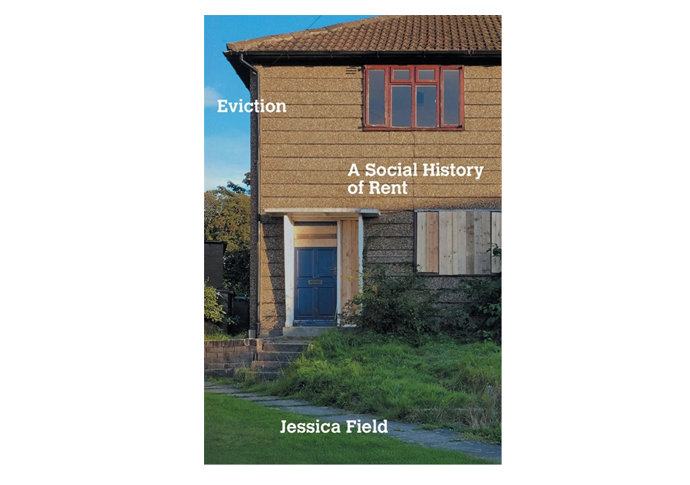‘We have never moved beyond the idea that a house is at the grace and favour of a landlord’
Perceived as ‘moveable masses’, tenants are often ignored by developers and landlords. Dan Carrier talks to the author of a book that examines the history of rented homes
Friday, 3rd October — By Dan Carrier

Save Our Homes LS26 Residents’ Action Group outside their homes in 2018
IT is a story of how a group of neighbours reacted when told their landlord was going to redevelop their homes and they would have to pack up and leave.
And on a wider level, Jessica Field’s book Eviction: A Social History of Rent, outlines a story that has been repeated across the UK and through the decades – and explains how something as important as a roof over our heads suffers from fundamental, systematic failings.
The backdrop to her story is “built-in obsolescence for renting workers’ homes, lucrative development contracts that have always benefitted the developer and rarely the tenant, the financialisation of housing, and endless cycles of eviction,” says Jessica.
“I highlight how, for 150 years, ordinary renters have been seen by political leaders, housebuilders, investors and industries as moveable masses.”
Eviction reveals a housing history of constant insecurity and the word “redevelopment” has become an acceptable term for tenant displacement and community dislocation.
“I call out the destructive impact of 150 years of broken promises for decent and secure rented homes,” says Jessica.
“We have never moved beyond the idea that a house is at the grace and favour of a landlord.
“Nor have we ever challenged the notion that displacement of the poorest in the name of progress – and sometimes even welfare – is unavoidable. A landlord’s power to evict, raise rents and redevelop is the very foundation of Britain’s housing sector – as well as its housing crisis.”
Jessica’s parents Hazell and Mark were living on the Oulton estate in the suburbs of Leeds.
Their homes dated from the postwar period – prefabs built for the National Coal Board, providing a home for the miners working in nearby pits.
In September 2017, Jessica’s family and neighbours found a one-page glossy leaflet pushed through their doors.
The landlord, a firm named Pemberstone, had set up a “public consultation” to be held a week after they casually dropped the news they planned to demolish the homes they’d just posted leaflets to.

Jessica Field, author of Eviction [Adam Hollier]
Pemberstone told the council the estate had a “transitory” community, so the demolition wasn’t going to harm anyone.
This was patently not true, Jessica eloquently explains.
They made no attempt to understand the heritage of the homes – part of a working-class history worth preserving – nor had they completed any surveys comparing demolition with refurbishment in terms of its environmental impact. If they had, argues Jessica, they would have seen clearly how refurbishment is less costly, better for tenants and better for the planet.
Tenants formed the Save Our Homes LS26 Residents’ Action Group. Jessica takes the reader through their struggle, and explains how this experience reflects nationally.
Hazell and her friends used social media and their local paper to keep the issue in the public eye, causing problems for the developers and Leeds Council.
“Rented houses, Save Our Homes argued, are homes for so many, and not wealth-making assets for the few. Tenanted communities need rights and protections,” says Jessica.
She describes the estate’s history and reveals how landlordism has, for decades, undermined the provision of decent housing.
Oulton was the product of a post-war need, but a golden era of state-built homes, as the post-1945 period is often considered, is an illusion.
“A pattern of shoddy construction, neglect and eviction was little different to the slum landlordism, clearances and redevelopments of the Victorian era,” explains Jessica.
“In order to tackle horrific slum conditions governments in the mid-50s prioritised building new homes first and slum clearance second, though they often went hand-in-hand.”
Alongside local authorities’ house-building programmes, nationalised industries built workers’ dwellings.
“The NCB became the country’s biggest landlord with upwards of half a million tenants,” says Jessica.
As the coal industry declined, the Oulton estate saw the residents’ mix widen, while retaining a working-class character.
“Many work in the public sector,” reflects Jessica. “My mum is an NHS administrator, my dad previously a factory worker and caretaker, and then an NHS driver.”
In the early 1980s, the estate was sold by the NCB to a private investment company.
In the 1990s, a house price boom saw evictions handed to 149 households. The cleared land was redeveloped into “fancy new middle-class houses sold off for home ownership”, and then Pemberstone bought the estate.
Refurbishment is regularly seen as a wasted investment by landlords – it may improve the homes, but if that isn’t reflected in rent rises, the point – making a profit – is lost.
“Refurbishment cost-cutting contributed to the deaths of 72 people in the Grenfell fire,” Jessica reflects.
“Substandard insulation was a factor contributing to the ferocity of the fire. Both the cladding and insulation failed key fire safety tests by the companies flogging them, but were chosen by the developers to keep costs down.”
Leeds council turned down Pemberstone’s bid to demolish the rest of the estate on the grounds of the impact on a community, and that outdoor spaces provided were too small.
The tenants were euphoric – but Pemberstone appealed to a Whitehall planning inspector. The inspector did not dispute the council’s key arguments but overruled them for the paradoxical reason that if no refurbishment scheme was planned, the estate would fall further into disrepair, meaning it was reasonable for Pemberstone to evict those living there.
As Jessica shows, Pemberstone were essentially rewarded for not looking after the homes people lived in.

“The inspector agreed there was heritage value and a cohesive and settled community – but without repairs the houses would need to be demolished and replaced – so why would a landlord do any repairs?”
Pemberstone’s appeal victory is a symptom of why housing provision needs root and branch reform, adds Jessica. In Camden, the cases of developers and neighbourhoods having conflicting aspirations is played out in the New Journal each week. In Chalk Farm, a development by builders Berkeley St George is due to be looked at by a planning inspector after Camden threw out a bid to cut the “affordable” housing element. Next door, a housing association has won permission to move households from their homes – many against their wishes – while they massively intensify the land.
In Kentish Town, a developer hopes to build a film studio with 50 per cent affordable housing – as long as they can build blocks of 24 storeys. In Camley Street, Agar Grove and Bacton, Gospel Oak, council-owned brownfield sites are to be redeveloped via a private / public partnership, where a compromise between community needs and developers’ profit will have to be struck.
Jessica highlights failures of a system reliant on private money to provide a public good.
“It should be tenants first – they have to be at the centre of housing reform,” she says.
“There needs to be meaningful consultation at every step of any development. Tenants are too often treated as invisible or irrelevant.
“Tenants should be considered leaders and consulted on design.
“LA’s have always had resource constraints and mandated numbers to meet. They need to be given the space and resources to think about the housing in their area, with powers to compulsory purchase unoccupied or under occupied houses, for example.”
The Right To Buy has decimated already under-resourced council housing stock.
“Labour is talking about removing the right to buy and that is an essential first step,” she adds. “But at minimum, local authorities should be able to spend money raised from the sale of council housing to replace stock.”
• Eviction: a Social History of Rent. By Jessica Field. Verso, £9.99